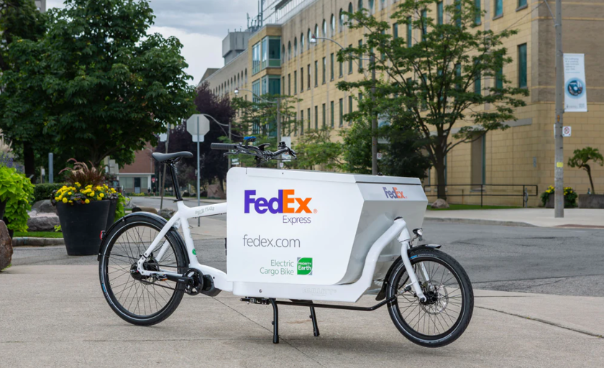More than half of the world’s population is currently located in urban areas, and this number is estimated to grow even further to an urban population of 68% in 2050 (Muñoz-Villamizar et al., 2020). Here, in Europe, the urban population is even greater as most people live in cities. Unfortunately, the urban areas are also the ones that are contributing the most to global warming (Muñoz-Villamizar et al., 2020). Due to this growth in urban areas as well as the rise of e-commerce and express deliveries, CO2 emissions and traffic congestion have increased significantly (Ralston, 2022). Urban Freight Transportation (UFT) entails the transportation of goods within urban environments. Within cities, UFT vehicles make up about 20-20% of all vehicles and contribute more to traffic congestion due to their size (Muñoz-Villamizar, 2020). Additionally, UFT is often considered to be the most polluting part of a company’s logistics chain, due to cargo trucks running on fossil fuels even when the packages are small and lightweight (Ralston, 2022).
To reduce their part in increasing traffic congestion and carbon emissions, several logistics companies have recently introduced the electric cargo bike. This vehicle is similar to a regular bike, however, it has a box, platform or basket added into the frame for the transportation of goods as you can see in the picture below. Additionally, the cargo bikes of logistic companies have electric pedal assistance to mitigate the load of all the packages. Currently, DHL is in the middle of a trial with these electric cargo bikes in Edinburgh, Scotland (Ralston, 2022). Furthermore, FedEx has put in place its first fleet in North America and Amazon has launched in England with the use of cargo bikes (Ralston, 2022).

This change in transportation means is an important one, as the cargo bikes are much more efficient and much less polluting than the trucks. In 2021, the cargo bike company Pedal Me found that their services were provided 1.61 quicker than the packages delivered by vans (Carrington, 2021). This shows the potential cargo bikes have for more efficient deliveries. Additionally, researchers have found that cargo bikes, in comparison to diesel vans, also reduce CO2 emissions by 90% and by 30% compared to electric vehicles (Carrington, 2021). Thus, showing promising results for the transformation towards greener e-commerce.
The cargo bikes also have multiple smart features, making efficient use of the “internet of things”. The DHL cargo bike, for example, is equipped with the newest GPS technologies to register movements and signal when a container is moved unlawfully (DHL, 2017). This allows for safety and makes sure, next to the container’s highly secure locks, that packages do not get stolen. Furthermore, couriers can see their most efficient route on a dashboard on their bikes (Ralston, 2022). This way they do not have to look at their mobile device while biking or make a stop to see where they need to go. Some cargo bikes even have solar panels installed on the top of the box or container to provide the power for the bike (DHL, 2017).
All in all, the electric cargo bike seems like an ideal solution to reduce humanity’s carbon footprint, at least within the urban areas. Does this mean that cargo trucks will be eliminated in cities? No, probably not. Right now, it is still impossible to carry extremely heavy and/or large parcels by cargo bike. Next to that, there are still a lot of cities that do not have the infrastructure necessary for cargo bikes couriers to safely bike around the city. However, the electric cargo bicycle does present an interesting opportunity for greener urban freight transportation, decreasing both CO2 emissions and traffic congestion.
References:
Carrington, D. (2021, August 25). Cargo bikes deliver faster and cleaner than vans, study finds. The Guardian. Retrieved 12 October 2022, from https://www.theguardian.com/world/2021/aug/05/cargo-bikes-deliver-faster-and-cleaner-than-vans-study-finds
Curbside Cycle. (2021, September 15). FedEx Launches First Official Cargo Bike Fleet Across Canada. Retrieved 10 October 2022, from https://curbsidecycle.com/blogs/blog/fedex-launches-first-north-american-fleet-of-cargo-bikes-for-last-mile-logistics
DHL. (2017, March 1). DHL launches new transport combination for urban distribution. DHL Parcel. Retrieved 10 October 2022, from https://www.dhlparcel.nl/en/business/knowledge-platform/news/city-hub
Muñoz-Villamizar, A., Santos, J., Montoya-Torres, J. R., & Velázquez-Martíneza, J. C. (2020, January). Measuring environmental performance of urban freight transport systems: A case study. Sustainable Cities and Society, 52. https://doi.org/10.1016/j.scs.2019.101844
Ralston, W. (2022, September 21). It’s Time for Cities to Ditch Delivery Trucks—for Cargo Bikes. WIRED. Retrieved 12 October 2022, from https://www.wired.com/story/cargo-bikes-greener-quicker/


Hi Natascha, a very interesting read! Being an EV enthusiast, this article piqued my interest. The concept of cargo bikes is quite fascinating and will definitely help with last-mile delivery. It will be highly beneficial in areas which have good infrastructure. But how efficient will they be in bad weather and other externalities? If going green and reducing carbon footprint is the agenda, wouldn’t smaller lightweight electric cargo vehicles be of better assistance. Just a thought.